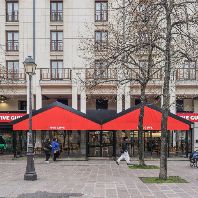The European commercial real estate investment market continues to recover, driven by an increase in demand for prime retail property assets, according to the latest CB Richard Ellis (CBRE) European Capital Markets report.
Direct European commercial real estate investment reached 28 billion in the first quarter of 2011 a 32% increase on the same period last year. The latest results, while lower than the 38.6 billion transacted in Q4 2010, are in line with the continuing increase in investment activity that started in late 2009 and was maintained through 2010.
Investment in retail property in Q1 2011 continued to grow at a greater pace than the rest of the European market, accounting for 43% of total transactions in the quarter. The 12.2 billion transacted represented a quarter-on-quarter increase of 4% and the highest quarterly total since Q4 2007.
Industrial and logistics property also experienced an uplift in investment activity in Q1 2011 to 2.8 billion. This is a significant increase over both the Q1 2010 and Q4 2010 figures and represents 10% of the European total in Q1 2011. The industrial sector also saw the steepest quarterly declines in yield, with the EU-27 Prime Yield Index falling 8 basis points (bps) to 7.72%. The recent recovery in the manufacturing sector, combined with yield premiums over other commercial sectors (still achievable even for prime logistic space), is expected to support further increases in investor demand toward the sector.
John Welham, Head of European Retail Investment, CBRE, commented: "Since the global economic downturn the vast majority of investors have focused on core assets and locations, and this remains the case today. However, throughout the latter part of 2010 and into 2011 the number and type of active investors broadened, and their interest shifted further along the risk curve. This shift in demand towards 'value add' is strongest in the retail sector, while geographically, the expectations are that Germany, Sweden, Spain, and CEE markets are set to benefit most in the short term."
Michael Haddock, Director of EMEA Capital Markets Research, CB Richard Ellis, commented: "The retail sector has continued to show strong growth and the evidence from both investment activity and pricing indicates that this sector is ahead of the rest of the market in terms of recovery. The uplift is being driven by the deep pockets of institutional investors looking to increase their direct exposure to the sector - a trend expected to continue to support further recovery at the core-end of the commercial real estate market generally."
The importance of the institutions is further magnified by the fact that European lending terms tightened further in Q1 2011, with margin increases reported even in core markets, such as France and Germany. Lack of confidence, ongoing withdrawals from international and real estate lending markets, and Basel III the new global regulatory standard on bank capital adequacy and liquidity agreed by the members of the Basel Committee on Banking Supervision - all point to restricted lending activity and upward pressure on margins continuing throughout 2011. The recent increases in euribor/libor swaps are another element adding to the total cost of financing.
Iryna Pylypchuk, Associate Director of EMEA Capital Markets Research, CB Richard Ellis, commented: "The prolonged lack of debt, the build-up of 'legacy loans', and the upcoming Basel III regulations have altered the landscape of the European real estate market. In stark contrast to the boom years, the role of debt has diminished and it now accounts for about 50% of European investment activity. This is no longer perceived to be a temporary change, but a structural shift. While there are pockets of robust lending activity at the core-end of the market and a growing emergence of new types of lender, investors' heavy reliance on debt is in the past, in Europe at least."
Source: CB Richard Ellis













